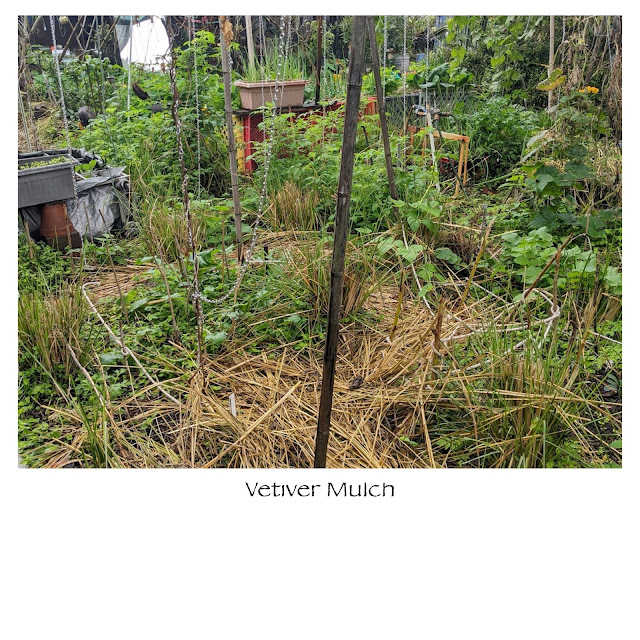I've tried to show all the elements:
- raised beds
- aerials
- mulch
- polycultural mix
- hard to show: I have just planted several chaya, aibika and bitter leaf bushes which hopefully will add significantly to my green leaf powder supply.They will become the backbone of foraging.
- Growing are: Timor lettuce, celery, parsley, coriander, cabbages, kale, tomato, beans, chia, chaya, bitter leaf, aibika, longevity spinach, okinawan spinach, spring onions, shallots, radishes, basil, egg plant, chillis, peppers, chives, choko, Tatume squash, Seminole pumpkin, asparagus, Jeruslaem artichokes, mitsuba, water spinach, artichoke pepper leaf...
You'll note the chains...I happen to get an aluminium chain door so I repurposed it as support lines for climbers, beans and tomatoes.
These chains are easy to work with because they are so soft. Their mesh allows perfect purchase for climbers and the like, and will tangle easily around tomato stems without cutting into them.
Best of all, they are easily moved about from plant to plant.
One doorway of chains is more than enough.
I hang them from the aerial lines above. As a rambling or climbing plant grows I position a chain above it.It's easy to pull the aerials into various positions to suit.
The bread tray beds have performed better than I imagined.
Held together with cable ties and lined with tarp -=- the soil consolidates the shape by pushing the tarp against the plastic frame.
The milk crates are a similar build except they are lined with weed mat.
The repurposed shelving shows the tarp offcuts I worked into the frame like doing papier mache overlays.
You can just see the terracotta wine coolers I have embedded in the raised beds. Thats' irrigation. I grow duckweed in them to reduce evaporation and suppress mosquitoes.
There are no patterns to the lines running through the sky.
Some are old garden hoses, others are rope.
I have attached them to trees bordering the patch and hold them up with cut bamboos and other timbers. They may wave in the wind but don't fall down.
CHAYA does not like the colder weather.With luck I should have at least ten chaya 'trees' powering away this Summer. So I hope to start selling cuttings next year. (Possibly 2 for $10).
I have the same horticulture plan for Bitter Leaf and Aibika because it's these three plants people have asked me for because I run a Vetiver nursery.
Some are old garden hoses, others are rope.
I have attached them to trees bordering the patch and hold them up with cut bamboos and other timbers. They may wave in the wind but don't fall down.
CHAYA does not like the colder weather.With luck I should have at least ten chaya 'trees' powering away this Summer. So I hope to start selling cuttings next year. (Possibly 2 for $10).
I have the same horticulture plan for Bitter Leaf and Aibika because it's these three plants people have asked me for because I run a Vetiver nursery.
I don't have a weed problem so much as an occasional 'Scurvy "Weed" ' problem -- a plant that has monopolised the weed niches.
The advantages being that it makes for a great ground cover, the worms love to live under it and it is so easy to remove (by raking) when I choose to.
You'll also note the upright grass clumps. Thats' Vetiver 1.5 metres apart. In there too are some Vetiver hedges recently planted.
Note the Vetiver clumps. Cut a few times over the year for mulch but growing in situ, they draw up moisture from the depths and fosters a rich microbiology WITHOUT competing with neighbouring plants because the roots go straight down.
Info on Vetiver's effect on soil biology: https://www.vetiver.org/.../soil-fertility-enhancement/
Note the chains.
It will be interesting how much chia I'll get from two hedges planted.
I use the stuff daily. Amazing seed!
I've just planted some Bottle Gourds for climbing up the chains.
It will be interesting how much chia I'll get from two hedges planted.
I use the stuff daily. Amazing seed!
I've just planted some Bottle Gourds for climbing up the chains.






